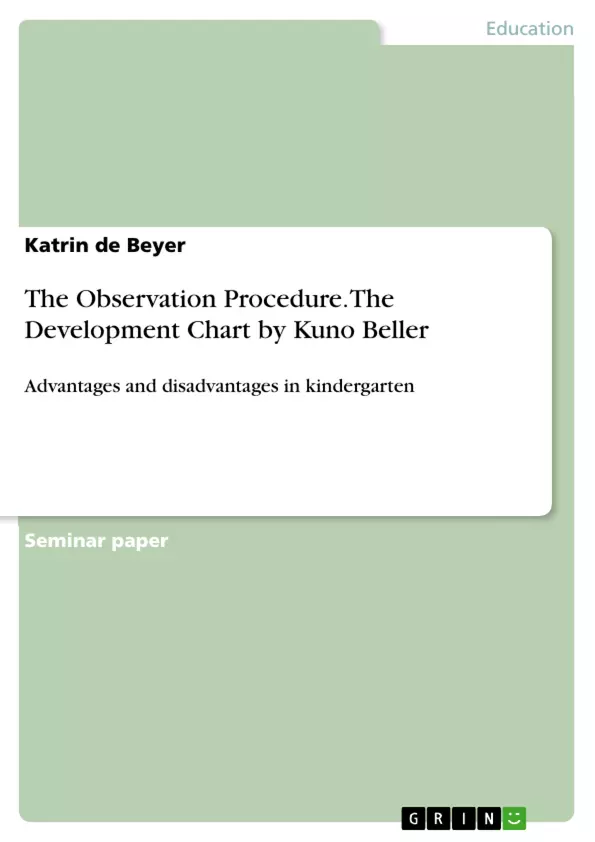This paper deals with the topic of observation and documentation, specifically with the development chart of Prof. Dr. E. K. Beller and S. Beller. First the term observation will be explained. In the further course it will be discussed why, what and how observation is done in practice.
To put the procedure in an overall context, the author presents an observation system and embeds the chart in it. The remainder of the paper describes in detail the structure, function, and application of the developmental chart and discusses the experiential opportunities it offers. Subsequently, the author describes her own experiences in the kindergarten and weighs the advantages and disadvantages of this procedure.
Inhaltsverzeichnis (Table of Contents)
- Introduction
- Basics of observation
- Definition
- Why do we observe?
- What do we observe?
- How do we observe?
- Classification in the observation system
- First pillar
- Second pillar
- Third pillar
- Kuno Beller's development chart
- Structure
- Function and application
- Calculation and evaluation
- Experience offers
- Summary
- Own experiences
- Advantages and disadvantages
- Summary
Zielsetzung und Themenschwerpunkte (Objectives and Key Themes)
This term paper aims to provide a comprehensive overview of observation and documentation, particularly focusing on the development chart created by Prof. Dr. E. K. Beller and S. Beller. It explores the definition, reasons, processes, and methods of observation. Furthermore, it examines the structure, function, and application of the development chart, emphasizing the experiences and insights gained from its use.
- Observation and documentation in educational institutions
- Definition and methods of observation
- The structure, function, and application of Kuno Beller's development chart
- Practical experiences with the development chart
- Advantages and disadvantages of the observation procedure
Zusammenfassung der Kapitel (Chapter Summaries)
- Introduction: Introduces the topic of observation and documentation, focusing on the development chart of Prof. Dr. E. K. Beller and S. Beller. Explains the purpose and structure of the term paper.
- Basics of observation: Defines observation, emphasizing the difference between free and systematic observation. Examines the reasons for observation in educational institutions, highlighting the importance of understanding children's behavior and developmental processes.
- Classification in the observation system: Presents a modular observation system with three pillars: procedures focusing on children's activities and development processes, feature-based procedures, and development screenings. Explains the importance of combining different observation methods.
- Kuno Beller's development chart: Discusses the development chart's structure, function, and application. Examines the experience offers derived from its use.
- Summary: Reports on personal experiences with the development chart in a kindergarten setting, weighing the advantages and disadvantages of this observation procedure.
Schlüsselwörter (Keywords)
The key terms and focus topics of this term paper include observation, documentation, development chart, Kuno Beller, educational institutions, children's behavior, developmental processes, observation system, feature-based procedures, development screenings, and practical experiences.
- Arbeit zitieren
- Katrin de Beyer (Autor:in), 2014, The Observation Procedure. The Development Chart by Kuno Beller, München, GRIN Verlag, https://www.grin.com/document/1176846



